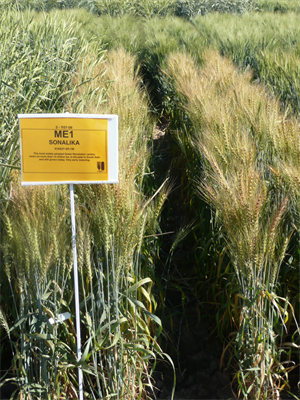PDF chapter test TRY NOW
What is plant breeding?
Plant breeding is the process of genetically improving crops to produce desired plant types, better suited for cultivation, giving better yields, and disease resistant. Plant breeding includes hybridisation of pure lines, artificial selection to create plants with desirable traits such as higher yield, nutrition and disease resistance.
What was the purpose of plant breeding?
India is an agricultural country, where agriculture contributes to about 33\% of India's GDP. During the post-independence period, India's major challenge or concern was having enough food production to feed the expanding population.
The development of various high yielding varieties of wheat and rice in the 1960s increases yield per unit area. The green revolution marked the beginning of the development of high-yielding crop varieties.
Breeding for high yield and better quality:
Wheat:
Between the years 1960 and 2000, wheat production increased from 11 \ million \ tonnes to 75 \ million \ tonnes, and rice production increased from 35 \ million \ tonnes to 90 \ million \ tonnes. It was because of the development of semi-dwarf varieties of wheat and rice.
Semi-Dwarf varieties in Wheat:
Sonalika and Kalyan Sona are semi-dwarf wheat varieties developed from Mexico's high-yielding, semi-dwarf, fertilizer-responsive wheat cultivars. They were introduced in the wheat-growing areas of India.

Sonalika wheat variety
Semi-Dwarf varieties in Rice:
The International Rice Research Institute (IRRI) in the Philippines developed IR-8 (Miracle rice), a high-yielding semi-dwarf rice cultivar. This was first introduced in the Philippines and India in 1966. It was a hybrid between the Indonesian high-yielding rice variety Peta and the Chinese dwarf variety Dee-geo-woo-gen (DGWG).

IR-8 rice variety
Later on, semi-dwarf varieties with better yield - Jaya and Ratna were developed.
Plant Breeding for Disease Resistance:
Pathogens such as viruses, bacteria, and fungus cause plant diseases and attack the cultivated crops. This has an impact on crop yield. The crop losses can be up to nearly 20 - 30 \%. As a result, developing disease-resistant crop types that increase yield while reducing the usage of fungicides and bactericides is important.
Example:
Some fungal diseases include brown rust of wheat, red rot of sugarcane and late potato blight. The bacterial disease includes the black rot of crucifers, and viral disease includes tobacco mosaic, turnip mosaic etc.
The following are some disease-resistant cultivars established through plant breeding:
Crop | Variety | Resistant to diseases |
| Wheat | Himgiri | Leaf and stripe rust, hill bunt |
| Cauliflower | Pusa Shubhra, Pusa Snowball K-1 | Black rot |
| Cowpea | Pusa Komal | Bacterial blight |
| Chilli | Pusa Sadabahar | Chilly mosaic virus, tobacco mosaic virus and leaf curl |
Important!
Dr G Nammalvar (1938-2013) was a Tamil environmental activist, agricultural scientist, and organic farming expert. To create public awareness of the advantages of organic farming, he founded Nammalvar Ecological Foundation for Farm Research and Global Food Security Trust (NEFFFRGFST - Vanagam).

Dr G. Nammalvar
Reference:
https://www.flickr.com/photos/cimmyt/8518215689
https://www.flickr.com/photos/ricephotos/8364167912
https://commons.wikimedia.org/wiki/File:Nammalvar.G.jpg
